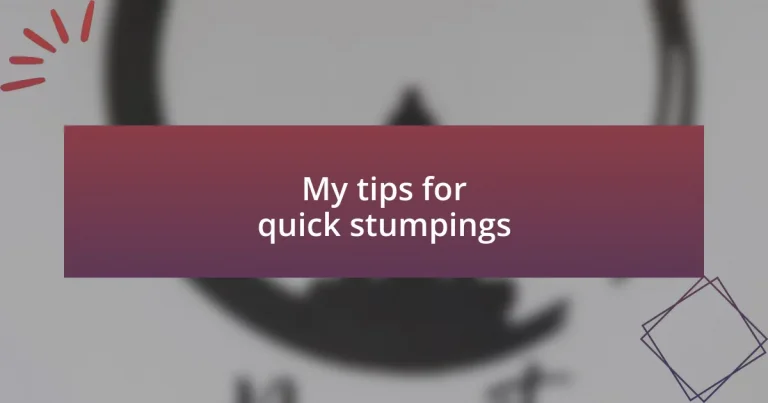Key takeaways:
- Stumpings require quick reflexes, keen anticipation, and effective footwork to succeed.
- Essential tools include quality wicketkeeping gloves, practice stumps, and mentorship for skill enhancement.
- Timing, mental focus, and communication with the bowler are critical for executing successful stumpings.
- Regular practice and simulation of match scenarios help develop the instinctive responses needed for quick stumpings.
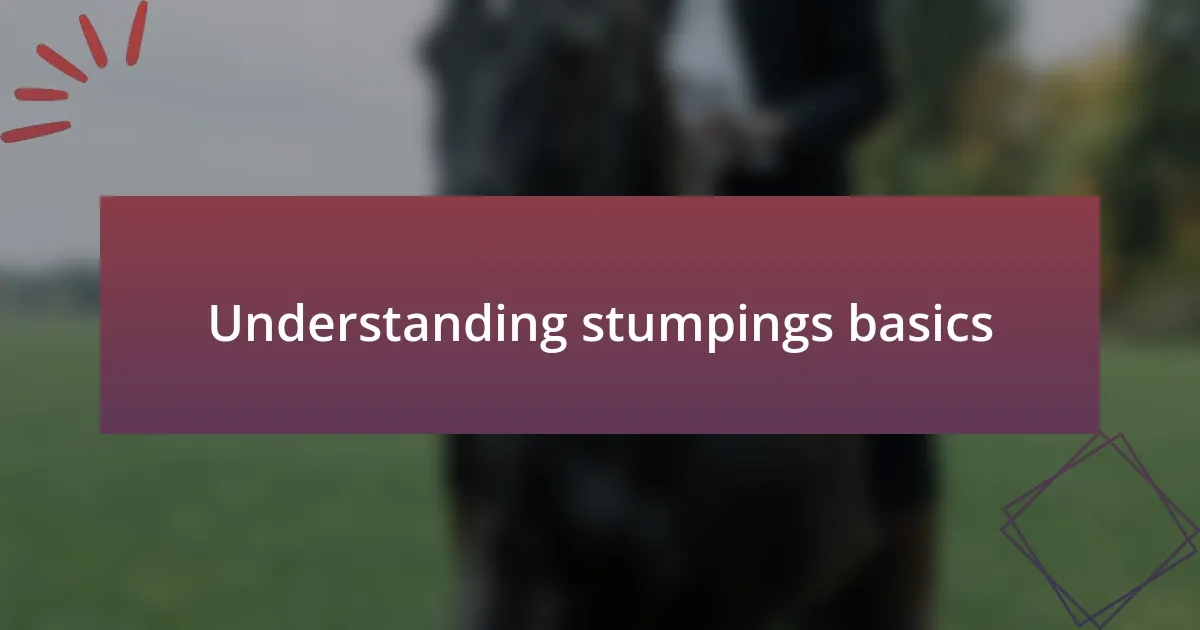
Understanding stumpings basics
Stumpings are a fascinating aspect of cricket, blending quick reflexes with sharp awareness. I remember watching a match where the wicketkeeper, with lightning speed, managed to dislodge the bails just after the batsman stepped out of the crease. It was a moment that left me in awe of the skill required for such a dismissal. Have you ever appreciated how a split-second decision can change the game’s momentum?
Understanding the mechanics of stumpings is crucial for both players and enthusiasts. Essentially, it occurs when a batsman steps out of their crease, and the wicketkeeper successfully removes the bails before they can return. The tension during these moments is palpable, and it’s remarkable how a tiny lapse in concentration can lead to a quick exit.
I’ve seen some wicketkeepers transform the game with their stumping abilities. They seem to have an innate sense of timing, almost anticipating when the batsman will venture too far forward. This insight reminds me of why I’ve always admired keepers like MS Dhoni, whose precision and quick thinking often left the opposing batsmen bewildered. It raises a thought-provoking question: as a player, how can you develop that same level of instinct and preparedness?
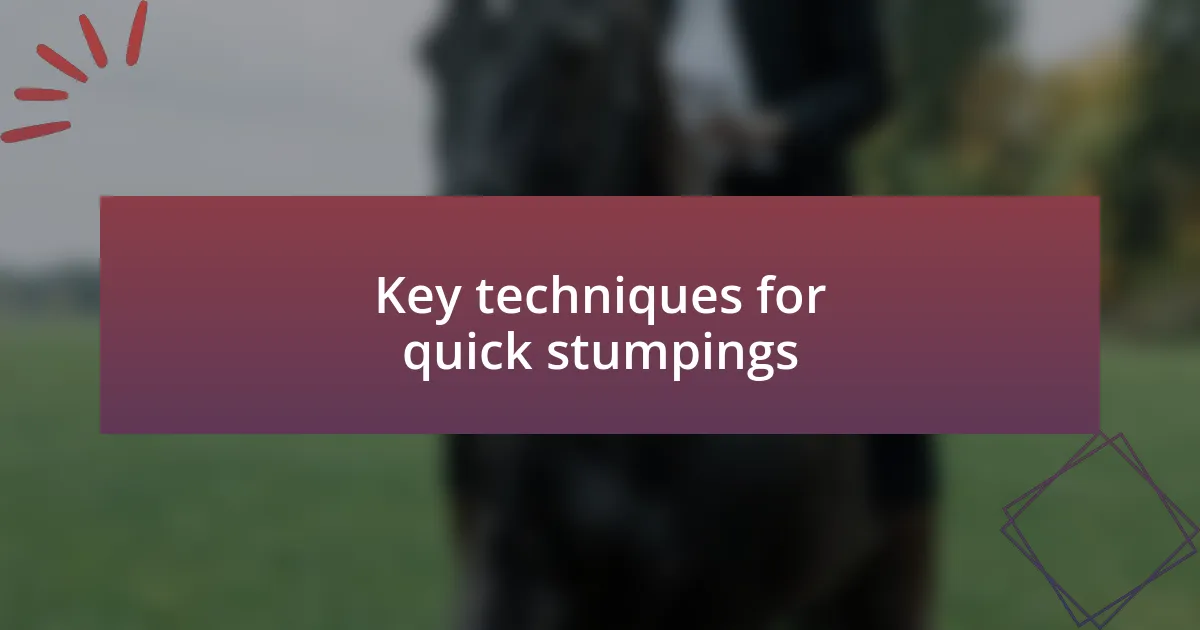
Key techniques for quick stumpings
Key techniques for quick stumpings
To achieve quick stumpings, mastering a few essential techniques is critical. Watching proficient keepers in action, I’ve learned the importance of footwork combined with hand-eye coordination. One unforgettable moment from my own playing days was realizing that a well-timed shuffle toward the stumps not only enhances your reach but also builds a connection with the bowler’s delivery, almost as if we were in sync.
Here are some key techniques to focus on:
– Anticipation: Develop a keen sense for reading the batsman’s movements.
– Quick Footwork: Be light on your feet and ready to move swiftly towards the stumps as the batsman ventures out.
– Catching Practice: Regularly practice catching the ball one-handed to improve grip under pressure.
– Bail Removal Technique: Use a smooth, swift motion to dislodge the bails; practice is essential.
– Mental Focus: Stay mentally engaged throughout the game to react instantly to the batsman’s decisions.
Reflecting on my time behind the stumps, I realize that a strong mental game plays a pivotal role in executing these techniques effectively. Each time I practiced these skills, I felt the adrenaline pump as I envisioned the exhilarating thrill of a successful stumping, reminiscent of those stunning moments that showcased the wicketkeepers’ artistry.
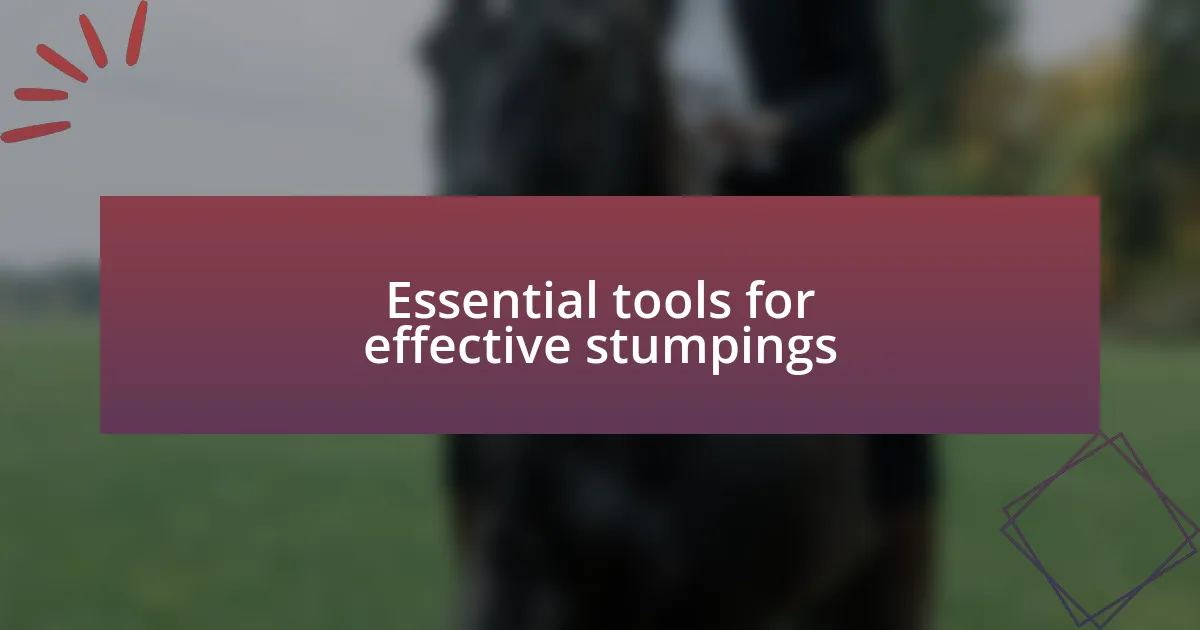
Essential tools for effective stumpings
To execute effective stumpings, it’s essential to have the right tools at your disposal. Personally, I always relied on a sturdy pair of gloves that offered both comfort and grip, allowing me to feel secure while attempting those split-second stumpings. The role of quality equipment cannot be overstated; using the right gear, like a well-fitted keepers’ helmet, not only ensures safety but also provides the confidence to focus on the task at hand.
Another crucial tool in my routine was the practice stumps themselves. I often set up a mini-session in my backyard to refine my skills. Practicing with these stumps brought me a sense of nostalgia, reminding me of childhood dreams of becoming a great wicketkeeper. It was during these sessions that I developed the muscle memory necessary for quick reflexes, truly highlighting how practice tools can bridge the gap between potential and performance.
Finally, never underestimate the value of a reliable coach or mentor. Having someone experienced to guide you through techniques and share insights is invaluable. I vividly remember the day my mentor pointed out how subtle adjustments in stance could enhance my footwork drastically. This tailored feedback made all the difference in my progress, reinforcing my belief in the power of collaboration in sports.
| Tool | Benefit |
|---|---|
| Wicketkeeping Gloves | Comfort and grip to ensure secure catches |
| Practice Stumps | Improves muscle memory and technique execution |
| Mentorship | Provides personalized feedback for skill enhancement |
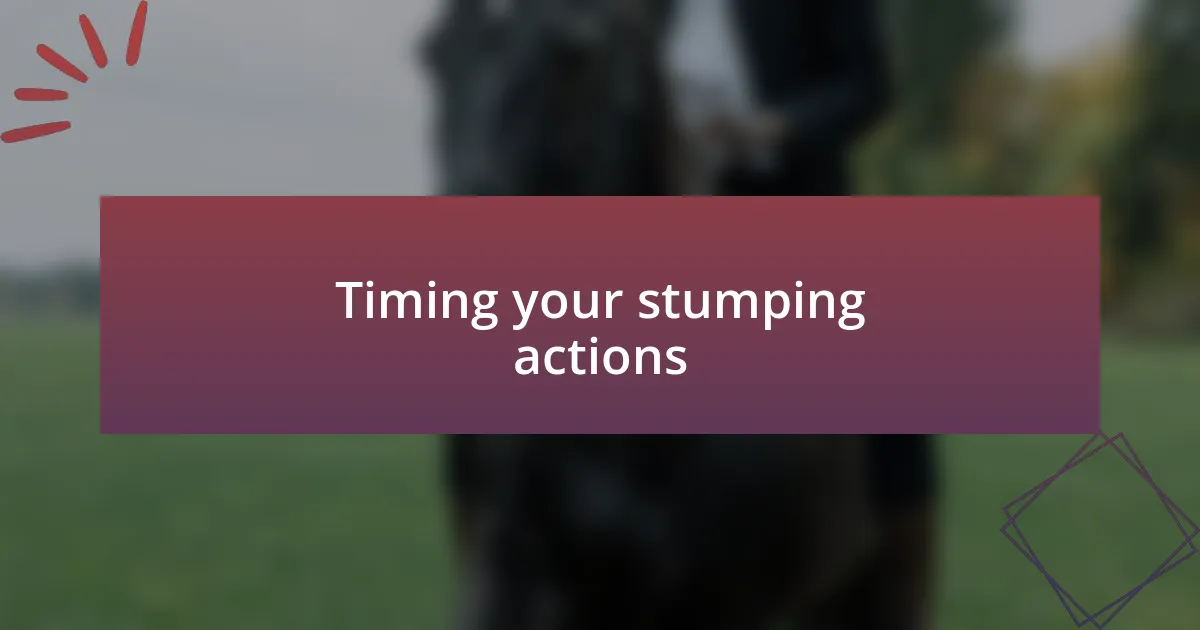
Timing your stumping actions
Timing in stumping actions is crucial; it can mean the difference between a spectacular dismissal or a missed opportunity. I remember one match where I misjudged the timing, ending up late to stump the batsman who had wandered too far down the pitch. That moment taught me the importance of being attuned to the rhythm of the game.
When it comes to timing, observing the bowler is key. I found that anticipating the pace of the delivery helps me gauge when to make my move. Have you ever noticed how a bowler’s body language shifts just before releasing the ball? Recognizing these subtle cues can significantly improve your reaction time.
Another lesson I learned is that there’s a fine line between hesitation and rushing. I recall one instance when I hesitated just a fraction longer, and by the time I moved, the opportunity had slipped away. It reinforced my belief that absolute focus and split-second decision-making are integral to successful stumpings; you need to commit fully to your instincts.
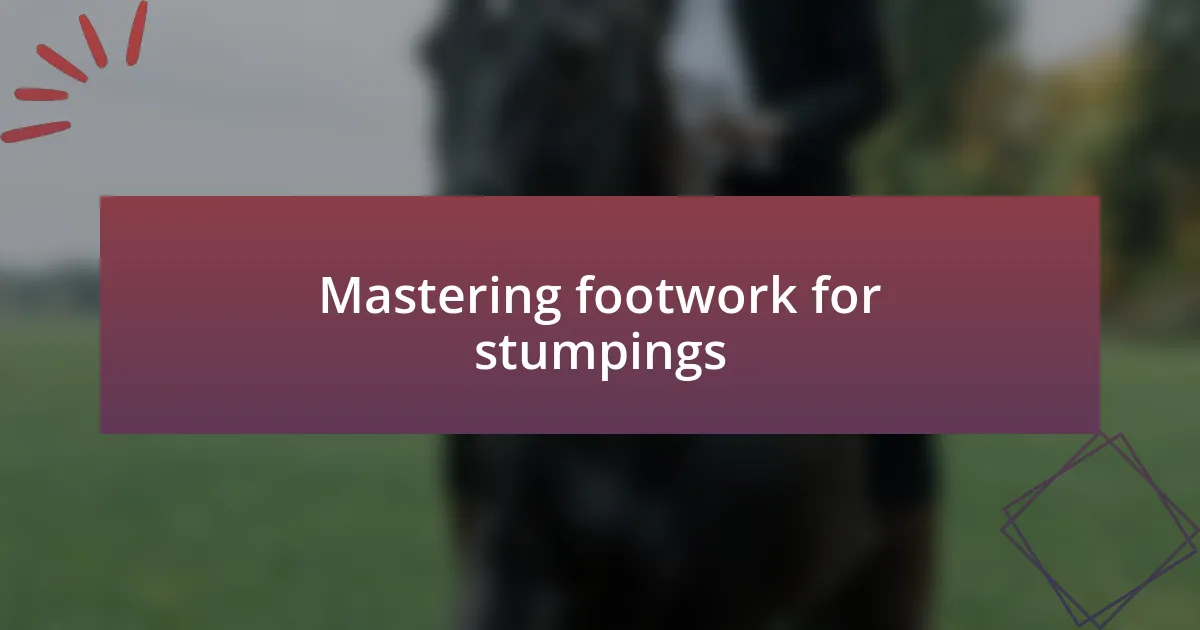
Mastering footwork for stumpings
Mastering footwork is essential for effective stumpings. I remember a particular match where my foot positioning made all the difference; by stepping decisively towards the stumps, I was able to perfectly align myself to execute a stumping that left the batsman bewildered. Have you ever found yourself caught off balance? It’s crucial to have a grounded stance that allows for quick lateral movements.
The key to agile footwork lies in rhythmic practice. I often dedicate time to drills, focusing on maintaining a low center of gravity while being light on my feet. This approach not only prepares me for various game scenarios but also builds muscle memory that aids in split-second decisions. It strikes me as fascinating how much of our performance is guided by instinctive movement, often honed through consistent repetition.
Another important aspect is the ability to read the batsman’s intentions. There was a game where the batsman’s foot movement hinted at an aggressive approach, prompting me to adjust my footwork immediately. Enhancing this skill not only boosts confidence but also places pressure back on the batsman, which can lead to increased mistakes. It’s all about creating that psychological edge while staying prepared to act swiftly.
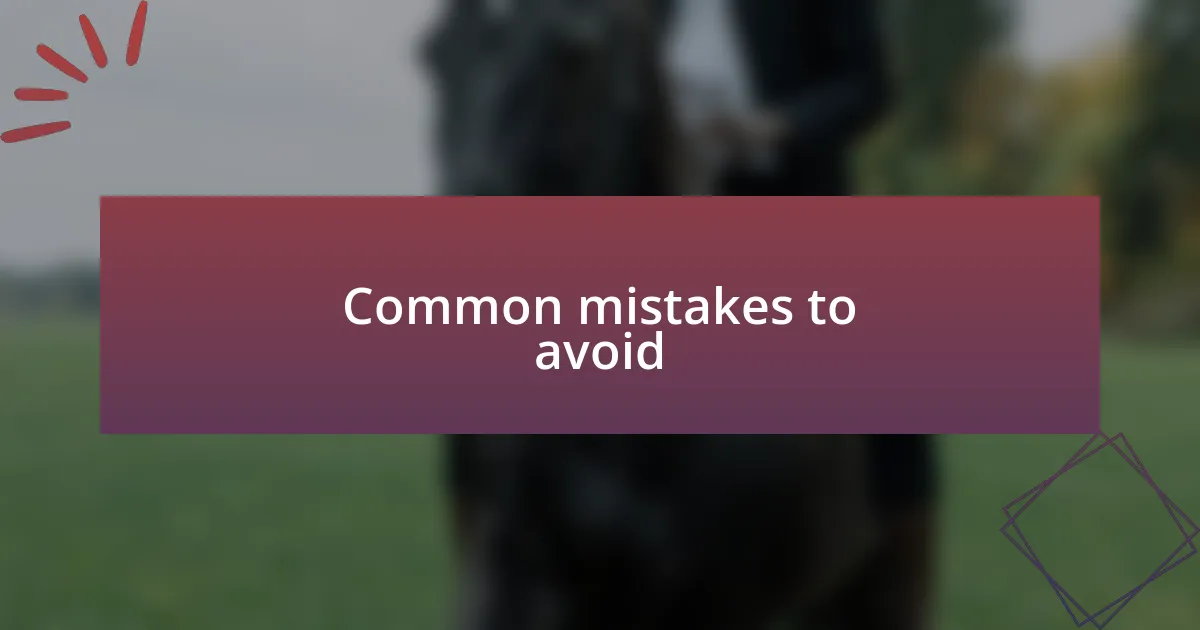
Common mistakes to avoid
It’s easy to overlook the importance of positioning when preparing for a stumping. I’ve been there; once, I found myself a little too far back in my crease, resulting in a missed opportunity that cost my team a key wicket. Have you ever felt that gut-wrenching moment when a batsman escapes purely due to your miscalculated stance? Always ensure you’re balanced and in a position to react—being too far away can leave you scrambling, and missing out on that clean stumping can haunt you.
Another common pitfall I’ve encountered is allowing distractions to affect my focus. During a tense match, I noticed myself becoming overly aware of the crowd’s reactions, which shattered my concentration. Have you ever tried to juggle multiple thoughts in your head while the game unfolds? I learned that clearing my mind before each delivery not only steadied my nerves but allowed me to react instinctively, which is crucial for executing those quick stumpings.
Finally, neglecting to communicate with your bowler can be detrimental. In one instance, I assumed the bowler knew my strategy without discussing it first, leading to a miscommunication that resulted in a stumping opportunity lost. Strong communication builds synergy; aren’t those moments when you feel completely in sync with your bowler something special? Always ensure you’re on the same page to maximize your chances; every little detail counts in the heat of the game.
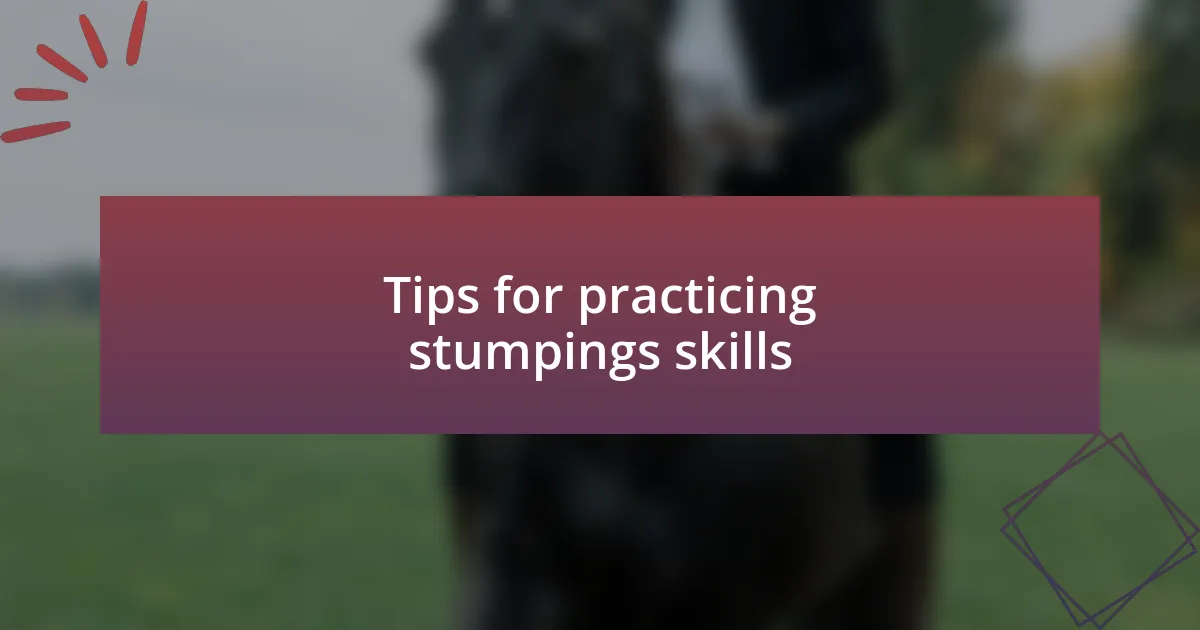
Tips for practicing stumpings skills
Practicing stumpings effectively can really elevate your game. I often set up drills where I focus solely on footwork and hand-eye coordination—two key components of a successful stumping. Have you ever tried these exercises? I remember one session where I repeatedly practiced moving quickly to my left and right while catching balls, which helped me develop reflexes that felt almost automatic during actual matches.
Another method that has stood out for me is to simulate match situations. I often gather a few teammates, and we recreate intense game scenarios that require quick stumpings. It’s amazing how much pressure can influence your performance; I once missed a stumping in practice because I wasn’t in the right mindset. Engaging in these realistic drills cultivates a level of comfort that makes stumping in real games feel second nature.
Lastly, analyzing my own stumping attempts has proven invaluable. After a match, I review footage or ask for feedback from my captain and teammates. Reflecting on those moments allows me to fine-tune my technique. Have you ever thought about how much you learn from watching yourself? I’ve discovered that this practice not only builds self-awareness but also helps solidify the lessons I’ve learned, giving me added confidence for the next time I’m behind the stumps.
